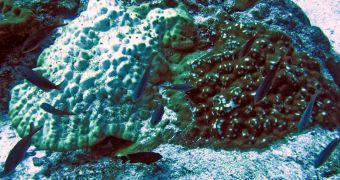As global warming continues to progress, the world's oceans are becoming increasingly acidic, due to their inability to capture and store carbon dioxide at the rate we are releasing it into the atmosphere. This acidification is affecting similar corals in different ways, a new study demonstrated.
The fact that climate change is endangering coral reefs around the world has been known for years, but thus far very few studies have been conducted on how resilience to warming waters and acidification varies among coral species.
The new research focused on two types of similarly-looking corals, which eventually revealed different coping mechanisms. One of these species also appears to be better able to handle acidification than the other. The study was led by scientists at the Pennsylvania State University.
Scientists with the Louisiana State University and the University of Costa Rica were also involved in the investigation, details of which were published in the December 12 issue of the esteemed scientific journal Proceedings of the Royal Society B.
“We've found that a previously unrecognized species was hiding some corals' ability to respond to climate change,” say Penn State biologist Iliana Baums, a co-leader of the study. The other leaders were Jennifer Boulay (Penn State), Jorge Cortes (UCR) and Michael Hellberg (LSU).
“These scientists have identified a 'cryptic,' or hidden, species in a common group of corals. The two corals have very different responses to their environment, and different interactions with other organisms on coral reefs,” says Michael Lesser.
Lesser holds an appointment as a program director with the Division of Ocean Sciences at the National Science Foundation (NSF). DOS provided the funds for the new investigation.
The two species of corals the team investigated are called Porites lobata and Porites evermanni. When the team sampled them from a reef in the eastern Pacific Ocean, they thought they had only gathered P. lobata specimens, but analysis in the lab revealed the presence of P. evermanni as well.
“That surprised us, the two look identical, and we thought they were the same coral species, but Porites evermanni has a very different genetic makeup. We knew about Porites evermanni, but we didn't expect to find it in the Eastern Pacific. Usually it's in the waters off the Hawaiian Islands,” Baums explains.
“If water temperatures continue to rise, coral species that succumb to bleaching more easily will die. We're going to see a shift in the relative abundance, for example, of these two Porites species,” she concludes.

 14 DAY TRIAL //
14 DAY TRIAL //